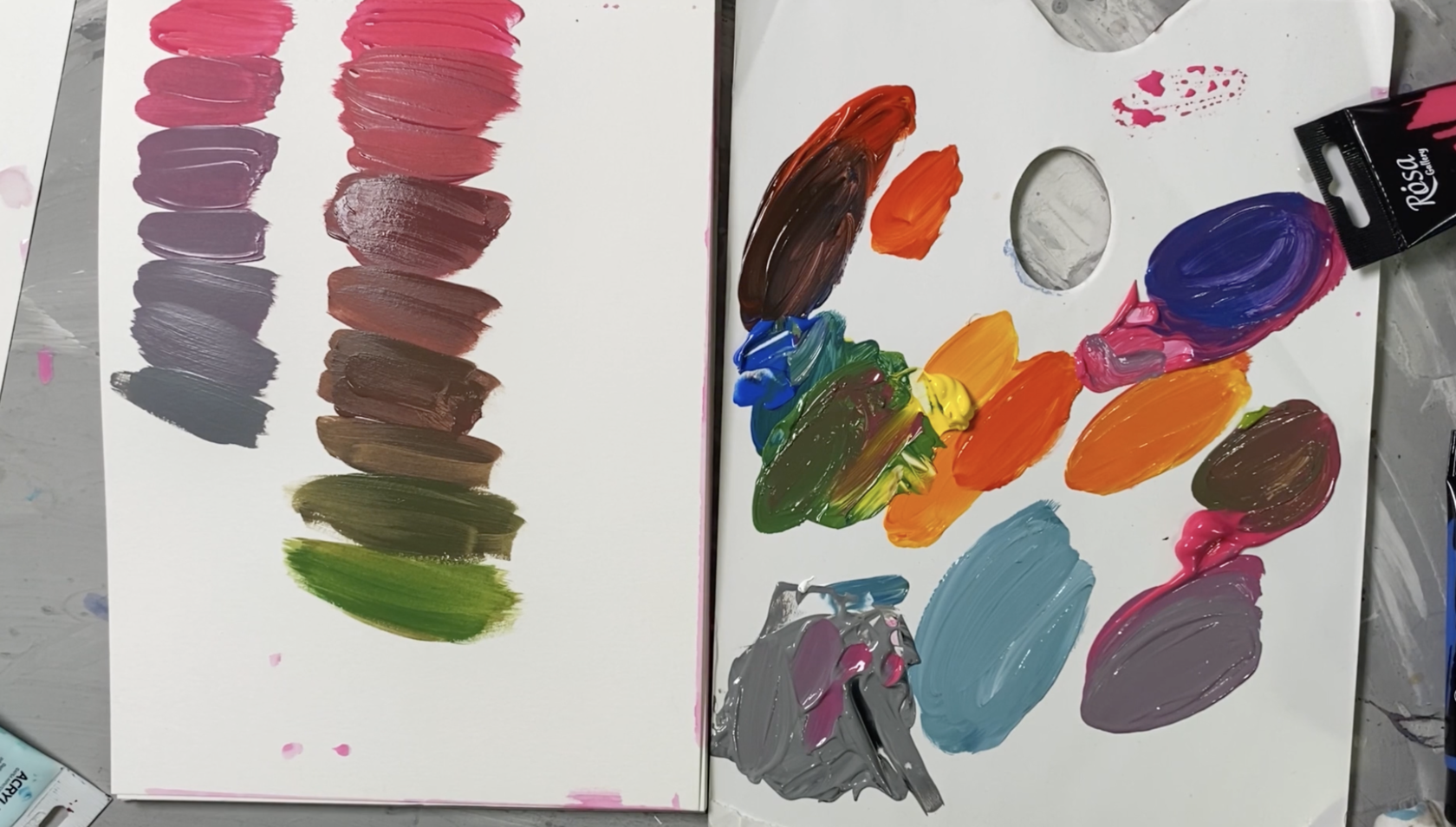Acrylic painting offers a vibrant and versatile medium for artists to express their creativity. One of the essential skills in acrylic painting is mastering the art of blending and layering. These techniques allow artists to create seamless transitions between colors, depths, and textures, resulting in captivating and visually stunning artworks. In this article, we will delve into the world of blending and layering in acrylic painting, exploring tips, techniques, and the creative potential they unlock.
Understanding Blending and Layering
Tools and Materials
Techniques for Blending and Layering
Tips for Success
Tools and Materials
Techniques for Blending and Layering
Tips for Success
UNDERSTANDING BLENDING AND LAYERING
Before we dive into the techniques, let's clarify what blending and layering mean in the context of acrylic painting.
Blending

Blending refers to the process of smoothly mixing two or more colors on the canvas to create gradual transitions between them. This technique is crucial for achieving soft edges, gradients, and realistic transitions in your artwork.
Layering

Layering involves the application of multiple coats of paint, one atop another. Each layer can introduce a unique color, texture, or opacity. Layering empowers artists to construct depth, imbue intricate details, and craft complex visual effects.
TOOLS AND MATERIALS
To excel in blending and layering, securing the right tools and materials is paramount:
- Acrylic Paints: Opt for high-quality acrylic paints boasting a diverse color spectrum. Acrylics are celebrated for their brilliant pigments and rapid drying properties, making them an ideal choice for blending and layering.
- Acrylic Brushes: Diverse brush types, including filbert, round, and flat brushes, facilitate the attainment of various blending and layering effects.
- Palette: A palette provides the perfect surface for mixing and blending your colors before they grace the canvas.
- Water or Acrylic Mediums: Water can be employed to dilute acrylic paint, rendering it more conducive to seamless blending. Acrylic mediums, like glazing or retarders, not only enhance blending but also extend drying time, affording more creative freedom.
- Canvas or Surface: Select a canvas or surface that aligns with your artistic vision. A smoother surface typically facilitates blending, whereas a textured one can infuse captivating layering effects.
TECHNIQUES FOR BLENDING AND LAYERING
In the intricate world of acrylic painting, mastering various blending and layering techniques can take your artwork from good to exceptional. Let's delve deeper into some advanced methods that will enable you to create captivating visual effects and add depth and complexity to your compositions.
Wet-on-Wet Blending: This technique involves applying fresh paint onto an area of the canvas where the paint is still wet. The magic happens as the colors interact and meld harmoniously. Wet-on-wet blending is ideal for creating seamless gradients and transitions. Experiment with blending different colors while the base layer is still wet to achieve captivating color interactions that appear almost effortless.
Dry Brushing: Dry brushing, on the other hand, requires a delicate touch. It involves using a nearly dry brush, lightly coated with a minimal amount of paint. This method allows you to layer paint gently, creating subtle textures and accents. Dry brushing is perfect for adding fine details, creating highlights, or enhancing the texture of your subject. By varying the pressure and direction of your brushstrokes, you can achieve a wide range of effects, from softly feathered edges to rugged, weathered textures.
Glazing: Glazing is a technique that can add depth, luminosity, and a touch of mystery to your artwork. It involves applying thin, transparent layers of color over dried layers of paint. These translucent glazes allow the underlying colors to subtly show through, creating a sense of depth and richness. Artists often use glazing to enhance the vibrancy of specific areas or to achieve a glossy, stained-glass effect. By carefully selecting your glazing colors and layering them strategically, you can achieve stunning visual results.
Scumbling: Scumbling is a dry brushing technique with a poetic touch. It involves gently layering a lighter color over a darker one, resulting in a soft, ethereal effect. This method is excellent for creating atmospheric effects, dreamy backgrounds, or adding a touch of magic to your artwork. The key to successful scumbling is achieving a delicate touch and maintaining a light hand, allowing the lower layer to peek through while diffusing the upper layer for a captivating, almost otherworldly appearance.
Feathering: Feathering is the art of delicately blending two colors by gently feathering their edges together. This technique produces seamless transitions between colors, ideal for creating soft gradients, subtle shadows, or realistic skin tones. Feathering requires precision and control, making it a valuable skill for artists seeking nuanced blending.
Palette Knife: Palette knives open up a world of possibilities for layering and adding texture to your acrylic paintings. These versatile tools allow you to work with thick impasto textures and create unique layering effects. By manipulating the paint with a palette knife, you can achieve bold, expressive strokes, sculptural effects, and even intricate details. Palette knives are particularly useful for artists looking to add dimension and character to their artwork, whether it's the impasto waves of the sea or the intricate details of architectural elements.
TIPS FOR SUCCESS
Start with a Plan: Before you dive into your acrylic painting, it's crucial to have a clear idea of your color palette and the desired transitions you want to achieve. Planning ahead will help you stay organized and achieve the desired effects.
Work Quickly: Acrylic paints have a fast drying time, so it's essential to work swiftly, especially when you're blending wet-on-wet. This technique relies on the fact that the paint is still wet, allowing colors to blend seamlessly.
Practice on a Palette: Before applying your paint to the canvas, take the time to experiment with blending and layering on your palette. This practice will help you get a feel for how the colors interact and allow you to refine your technique.
Use Soft Brushes: When it comes to blending, soft brushes like filberts are your best friend. Their smooth edge allows for seamless blending of colors, making it easier to achieve those gradual transitions.
Layer Gradually: Building up your layers gradually is key to achieving smooth transitions. Allow each layer to dry before adding the next one. This method ensures that you have better control over the blending process.
Explore Texture: Don't confine yourself to smooth blending. Embrace texture in your layers to add depth and interest to your artwork. Experiment with different brush strokes and layering techniques to create unique effects and give your painting a captivating tactile quality.
Work Quickly: Acrylic paints have a fast drying time, so it's essential to work swiftly, especially when you're blending wet-on-wet. This technique relies on the fact that the paint is still wet, allowing colors to blend seamlessly.
Practice on a Palette: Before applying your paint to the canvas, take the time to experiment with blending and layering on your palette. This practice will help you get a feel for how the colors interact and allow you to refine your technique.
Use Soft Brushes: When it comes to blending, soft brushes like filberts are your best friend. Their smooth edge allows for seamless blending of colors, making it easier to achieve those gradual transitions.
Layer Gradually: Building up your layers gradually is key to achieving smooth transitions. Allow each layer to dry before adding the next one. This method ensures that you have better control over the blending process.
Explore Texture: Don't confine yourself to smooth blending. Embrace texture in your layers to add depth and interest to your artwork. Experiment with different brush strokes and layering techniques to create unique effects and give your painting a captivating tactile quality.
In Conclusion
Blending and layering are cornerstone techniques for any acrylic artist. They unlock a universe of creative possibilities, enabling artists to capture seamless transitions and craft complex depth and texture. By mastering these techniques and experimenting with various tools and materials, you can elevate your acrylic paintings to new heights. Embark on your artistic journey, mix your colors, and start blending and layering your way to mastery, crafting artworks that captivate and inspire.
Blending and layering are cornerstone techniques for any acrylic artist. They unlock a universe of creative possibilities, enabling artists to capture seamless transitions and craft complex depth and texture. By mastering these techniques and experimenting with various tools and materials, you can elevate your acrylic paintings to new heights. Embark on your artistic journey, mix your colors, and start blending and layering your way to mastery, crafting artworks that captivate and inspire.











